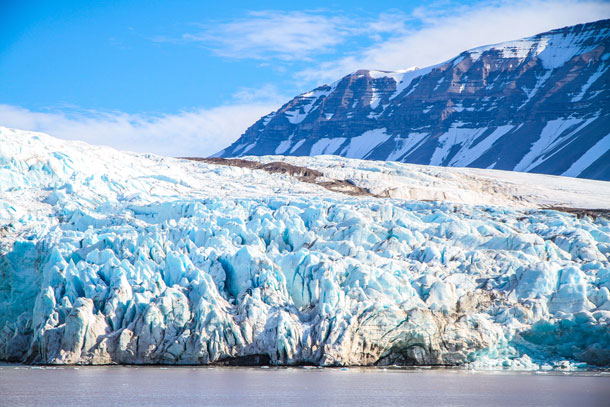Confronting Climate Change Through Sound
Air Date: Week of August 16, 2019

As glaciers shift and melt, many unsuspected sounds can emerge from the ice. (Photo: Unsplash, Vince Gx)
The seemingly constant onslaught of grim statistics and graphs about climate change may cause some people to shut down, unwilling or unable to process one of the most serious environmental issues of our time. To draw people back into a conversation about our changing climate, researchers at the University of Virginia are using something called eco-acoustics – sounds that illustrate the relationship between humans and their environment. Reporter Sandy Hausman has the story.
Transcript
BASCOMB: When we see statistics and graphs about climate change, many of us may start to shut down, unwilling or unable to process one of the most serious environmental issues of our time. To draw people back into a conversation about our changing climate, researchers at the University of Virginia are using something called eco-acoustics – sounds that illustrate the relationship between humans and their environment. Reporter Sandy Hausman has the story.
HAUSMAN: Willis Jenkins teaches religious studies, but lately he’s been called to the coast, to record the sounds of sea level rise and oyster reefs.
JENKINS: When you hear the reef recording you’re going to hear a snapping or cracking sound, and that is actually pistol shrimp, and then you can also hear kind of micro-currents of water moving in and around the reef, and there may be a few low fish calls.”
HAUSMAN: People who hear that recording are drawn into dialogue.
JENKINS: The sound element is so captivating that people ask lots of questions about it, and then they begin to ask questions about organisms and data change over decades, in conversations that typically go longer than if I were to just tell you about the health of these wetlands.
HAUSMAN: His colleague in UVA’s music department agrees. Matthew Burtner is now working from a cabin near Anchorage, where he’s recording glaciers as they melt slowly --- or suddenly fall into the sea.
BURTNER: It’s an amazing symphony of sounds actually. There are incredibly low, booming sounds. They sound like jet engines up close as these large pieces of ice calve and fall, and then there are most delicate tinkling, trickling sounds that you’ve ever heard – these little tiny patterns of water moving across the ice as the ice melts and creates little tiny melodies, little tiny rhythms, and the whole surface of the glacier is just alive with sound.
HAUSMAN: After recording the sounds of the arctic, he translates climate data into notes and combines them to create compositions that tell the story of global warming. Hearing it, he says, is fundamentally different from reading or talking about climate change.
BURTNER: A lot happens when we shift our focus from looking at the world and moving in the world to just listening to the world. It’s a more contemplative way of being. If we could understand the glaciers as a complex symphony of sound the way we listen to Beethoven, that could do a lot for our relationship to the natural world.
HAUSMAN: The work itself is challenging. It was 65 degrees in Charlottesville when I reached Burtner in Alaska’s Chugach Mountains. There, he said, conditions were very different.
BURTNER: Today it’s three degrees and it’s snowing outside. You know, to do anything you have to shovel out and then you’re constantly trying to keep the equipment warm, because the equipment is not designed to function in sub-zero temperatures.
HAUSMAN: But he loves being outside in any weather, and recording off the Eastern Shore is a pleasure. He and Jenkins can now assess the health of an oyster reef through sound and monitor the size of crustaceans by listening to what they call crab flutes – sounds heard as the wind blows over holes in the sand.
BURTNER: We hoped to be able to record the crab, but the crab made almost no sound, and we couldn’t hear it, but we could hear the wind whistling over the top of the crab glute – this wind instrument that the crab has made.
HAUSMAN: You can hear Burtner’s work on his newly released album, Glacier Music on Revallo Records, featuring what will surely be a hit song entitled the “Syntax of Snow”.
For Living on Earth, I’m Sandy Hausman.
BASCOMB: Sandy Hausman’s story comes to us courtesy of WVTF in Charlottesville, Virginia.
Links
Living on Earth wants to hear from you!
Living on Earth
62 Calef Highway, Suite 212
Lee, NH 03861
Telephone: 617-287-4121
E-mail: comments@loe.org
Newsletter [Click here]
Donate to Living on Earth!
Living on Earth is an independent media program and relies entirely on contributions from listeners and institutions supporting public service. Please donate now to preserve an independent environmental voice.
NewsletterLiving on Earth offers a weekly delivery of the show's rundown to your mailbox. Sign up for our newsletter today!
 Sailors For The Sea: Be the change you want to sea.
Sailors For The Sea: Be the change you want to sea.
 The Grantham Foundation for the Protection of the Environment: Committed to protecting and improving the health of the global environment.
The Grantham Foundation for the Protection of the Environment: Committed to protecting and improving the health of the global environment.
 Contribute to Living on Earth and receive, as our gift to you, an archival print of one of Mark Seth Lender's extraordinary wildlife photographs. Follow the link to see Mark's current collection of photographs.
Contribute to Living on Earth and receive, as our gift to you, an archival print of one of Mark Seth Lender's extraordinary wildlife photographs. Follow the link to see Mark's current collection of photographs.
 Buy a signed copy of Mark Seth Lender's book Smeagull the Seagull & support Living on Earth
Buy a signed copy of Mark Seth Lender's book Smeagull the Seagull & support Living on Earth

